ESP FIAT IDEA 2009 1.G User Guide
[x] Cancel search | Manufacturer: FIAT, Model Year: 2009, Model line: IDEA, Model: FIAT IDEA 2009 1.GPages: 210, PDF Size: 3.62 MB
Page 64 of 210

63
SAFETY
STARTING
AND DRIVING
WARNING
LIGHTS AND
MESSAGES
IN AN
EMERGENCY
MAINTENANCE
AND CARE
TECHNICAL
SPECIFICATIONS
ALPHABETICAL
INDEX
DASHBOARD
AND CONTROLS
CRUISE CONTROL
(constant speed
regulator) (where
provided)
It is a device able to support the driver,
with electronic control, which allows dri-
ving at speed over 30 km/h on long and
straight dry roads (e.g.: motorways), at a
desired speed, without pressing the ac-
celerator pedal. Therefore it is not sug-
gested to use this device on extra-urban
roads with traffic. Do not use it in town.
TURING THE DEVICE ON
Turn the ring A-fig. 75to ON.
The device can be turned on in 4th or 5th
gear only. Travelling downhill with the de-
vice engaged, the car speed may increase
more than the memorised one.
When the device is activated the warn-
ing light
Üturns on together with the rel-
evant message on the instrument panel
(where provided).
fig. 75F0H0074m
STORING THE SPEED
Proceed as follows:
❒turn ring A-fig. 75to ONand press
the accelerator pedal to the required
speed;
❒push the lever upwards (+) for at
least 1 second, then release it: the
car speed will be stored. The accel-
erator pedal may be released.
If needed (e.g. for overtaking), press the
accelerator pedal to accelerate: the car
will return to the previously set speed
when the pedal is released.RESTORING MEMORIZED
SPEED
If the device has been disengaged, for ex-
ample by pressing the brake or clutch ped-
al, the memorized speed can be reset as
follows:
❒accelerate gradually until reaching a
speed approaching the stored speed;
❒engage the gear selected when the
speed was stored (4th or 5th gear);
❒press button RES B-fig. 75.
INCREASING THE MEMORIZED
SPEED
The stored speed can be increased in two
ways:
❒by pressing the accelerator and then
storing the new speed reached;
or
❒ by moving the stalk upwards (+).
Each operation of the stalk will correspond
to a slight increase in speed (about 1 km/h),
while keeping the stalk upwards will cor-
respond to a continuous speed increase.
When travelling with the de-
vice on, never set the
gearshift lever to neutral.
WARNING
Page 65 of 210
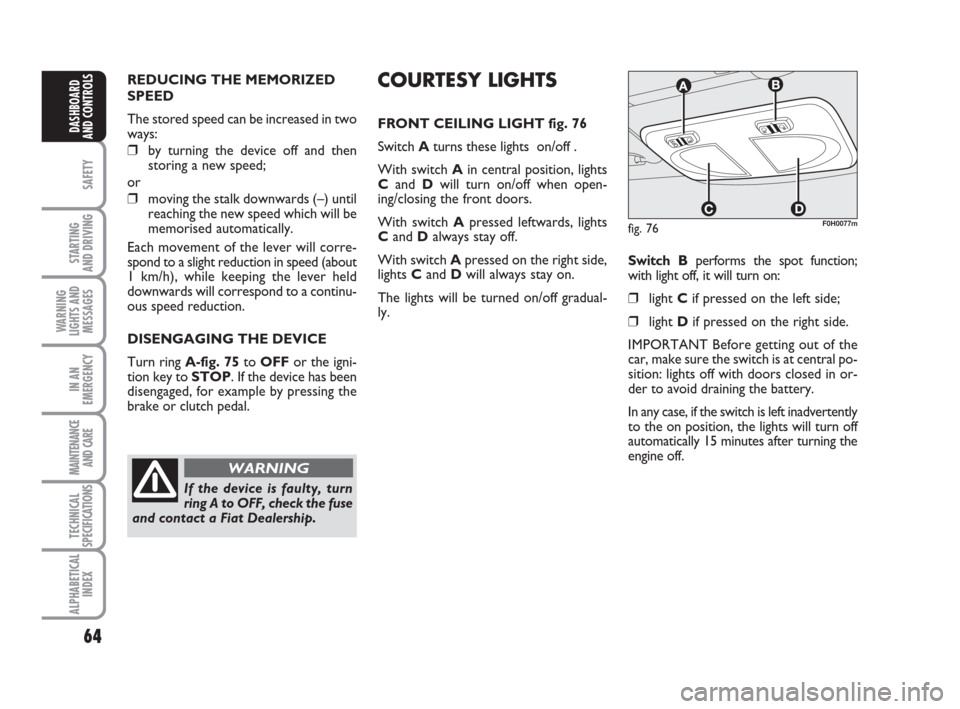
64
SAFETY
STARTING
AND DRIVING
WARNING
LIGHTS AND
MESSAGES
IN AN
EMERGENCY
MAINTENANCE
AND CARE
TECHNICAL
SPECIFICATIONS
ALPHABETICAL
INDEX
DASHBOARD
AND CONTROLS
REDUCING THE MEMORIZED
SPEED
The stored speed can be increased in two
ways:
❒by turning the device off and then
storing a new speed;
or
❒ moving the stalk downwards (–) until
reaching the new speed which will be
memorised automatically.
Each movement of the lever will corre-
spond to a slight reduction in speed (about
1 km/h), while keeping the lever held
downwards will correspond to a continu-
ous speed reduction.
DISENGAGING THE DEVICE
Turn ring A-fig. 75to OFFor the igni-
tion key to STOP. If the device has been
disengaged, for example by pressing the
brake or clutch pedal.
If the device is faulty, turn
ring A to OFF, check the fuse
and contact a Fiat Dealership.
WARNING
COURTESY LIGHTS
FRONT CEILING LIGHT fig. 76
Switch Aturns these lights on/off .
With switch Ain central position, lights
Cand Dwill turn on/off when open-
ing/closing the front doors.
With switch Apressed leftwards, lights
Cand Dalways stay off.
With switch Apressed on the right side,
lights C andD will always stay on.
The lights will be turned on/off gradual-
ly.Switch Bperforms the spot function;
with light off, it will turn on:
❒ light Cif pressed on the left side;
❒light Dif pressed on the right side.
IMPORTANT Before getting out of the
car, make sure the switch is at central po-
sition: lights off with doors closed in or-
der to avoid draining the battery.
In any case, if the switch is left inadvertently
to the on position, the lights will turn off
automatically 15 minutes after turning the
engine off.
fig. 76F0H0077m
Page 69 of 210
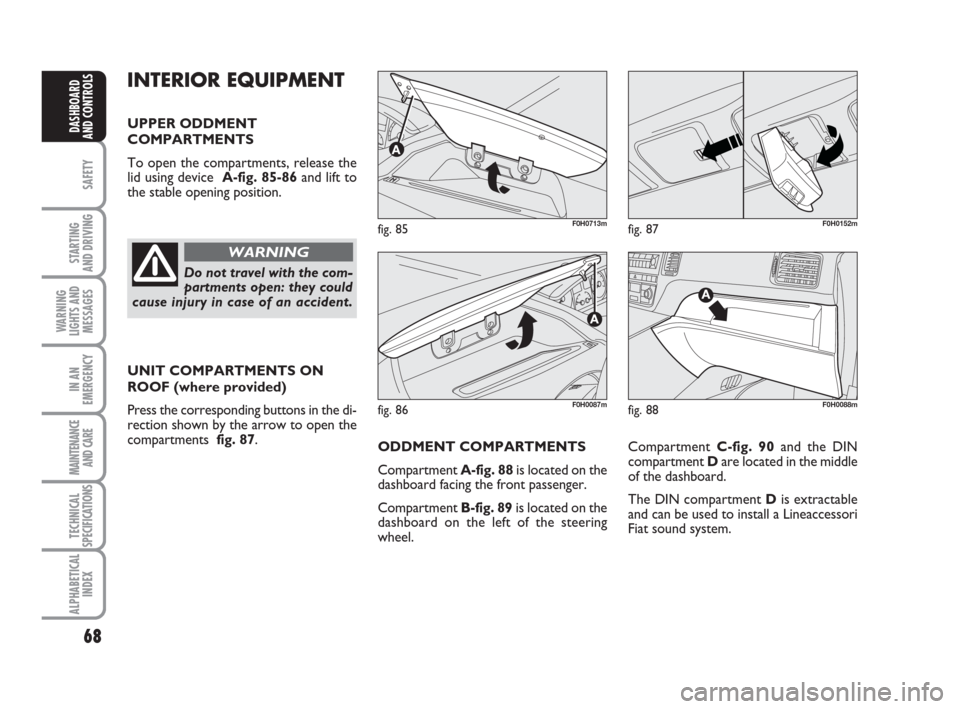
68
SAFETY
STARTING
AND DRIVING
WARNING
LIGHTS AND
MESSAGES
IN AN
EMERGENCY
MAINTENANCE
AND CARE
TECHNICAL
SPECIFICATIONS
ALPHABETICAL
INDEX
DASHBOARD
AND CONTROLS
INTERIOR EQUIPMENT
UPPER ODDMENT
COMPARTMENTS
To open the compartments, release the
lid using device A-fig. 85-86 and lift to
the stable opening position.
UNIT COMPARTMENTS ON
ROOF (where provided)
Press the corresponding buttons in the di-
rection shown by the arrow to open the
compartments fig. 87.
fig. 85F0H0713m
fig. 86F0H0087m
fig. 87F0H0152m
Do not travel with the com-
partments open: they could
cause injury in case of an accident.
WARNING
Compartment C-fig. 90and the DIN
compartment Dare located in the middle
of the dashboard.
The DIN compartment Dis extractable
and can be used to install a Lineaccessori
Fiat sound system.
fig. 88F0H0088m
ODDMENT COMPARTMENTS
Compartment A-fig. 88is located on the
dashboard facing the front passenger.
Compartment B-fig. 89is located on the
dashboard on the left of the steering
wheel.
Page 76 of 210

75
SAFETY
STARTING
AND DRIVING
WARNING
LIGHTS AND
MESSAGES
IN AN
EMERGENCY
MAINTENANCE
AND CARE
TECHNICAL
SPECIFICATIONS
ALPHABETICAL
INDEX
DASHBOARD
AND CONTROLS
PASSENGER AND REAR DOORS
(where provided)
The switch operating the corresponding
window is located on the internal armrest
of each door.
Incorrect use of the power
windows may be dangerous.
Before operation, always check that
no-one is exposed to the risk of being
injured by directly by the moving win-
dow or objects getting caught and
dragged. When leaving the car, al-
ways remove the key from the igni-
tion device to avoid the risk of injury
due to accidental operation of the
power windows.
WARNINGfig. 105F0H0156m
REAR MANUAL
WINDOW WINDERS
(where provided)
Operate the corresponding handle
fig. 105to open/close the window.
Page 80 of 210
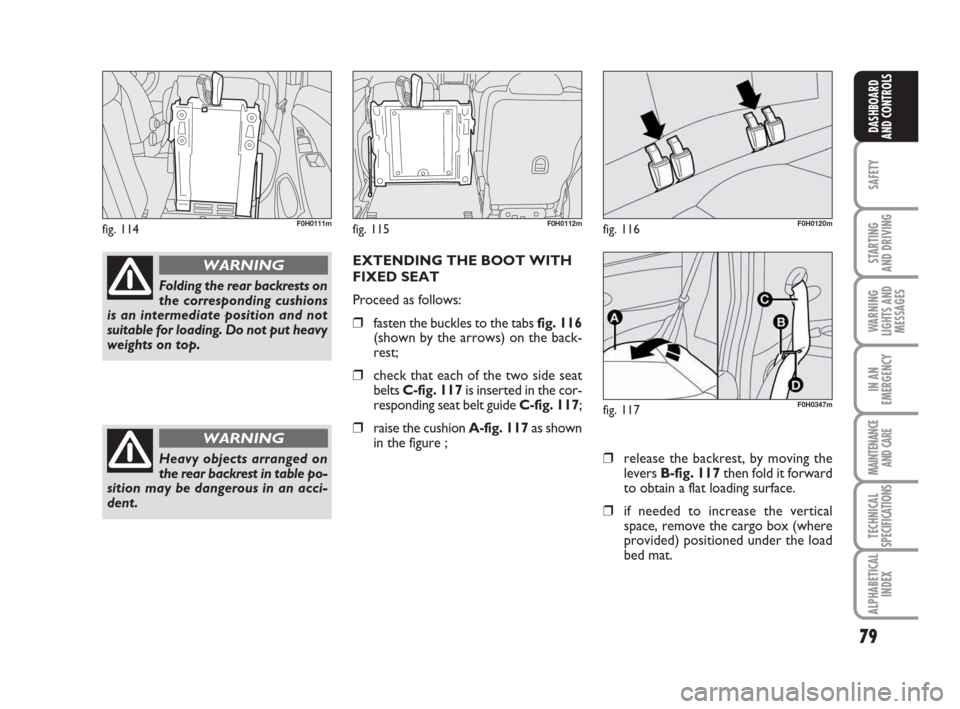
79
SAFETY
STARTING
AND DRIVING
WARNING
LIGHTS AND
MESSAGES
IN AN
EMERGENCY
MAINTENANCE
AND CARE
TECHNICAL
SPECIFICATIONS
ALPHABETICAL
INDEX
DASHBOARD
AND CONTROLS
Folding the rear backrests on
the corresponding cushions
is an intermediate position and not
suitable for loading. Do not put heavy
weights on top.
WARNING
Heavy objects arranged on
the rear backrest in table po-
sition may be dangerous in an acci-
dent.
WARNING
fig. 114F0H0111mfig. 115F0H0112m
EXTENDING THE BOOT WITH
FIXED SEAT
Proceed as follows:
❒fasten the buckles to the tabs fig. 116
(shown by the arrows) on the back-
rest;
❒check that each of the two side seat
belts C-fig. 117is inserted in the cor-
responding seat belt guide C-fig. 117;
❒raise the cushion A-fig. 117as shown
in the figure ;
fig. 116F0H0120m
fig. 117F0H0347m
❒release the backrest, by moving the
levers B-fig. 117then fold it forward
to obtain a flat loading surface.
❒if needed to increase the vertical
space, remove the cargo box (where
provided) positioned under the load
bed mat.
Page 84 of 210
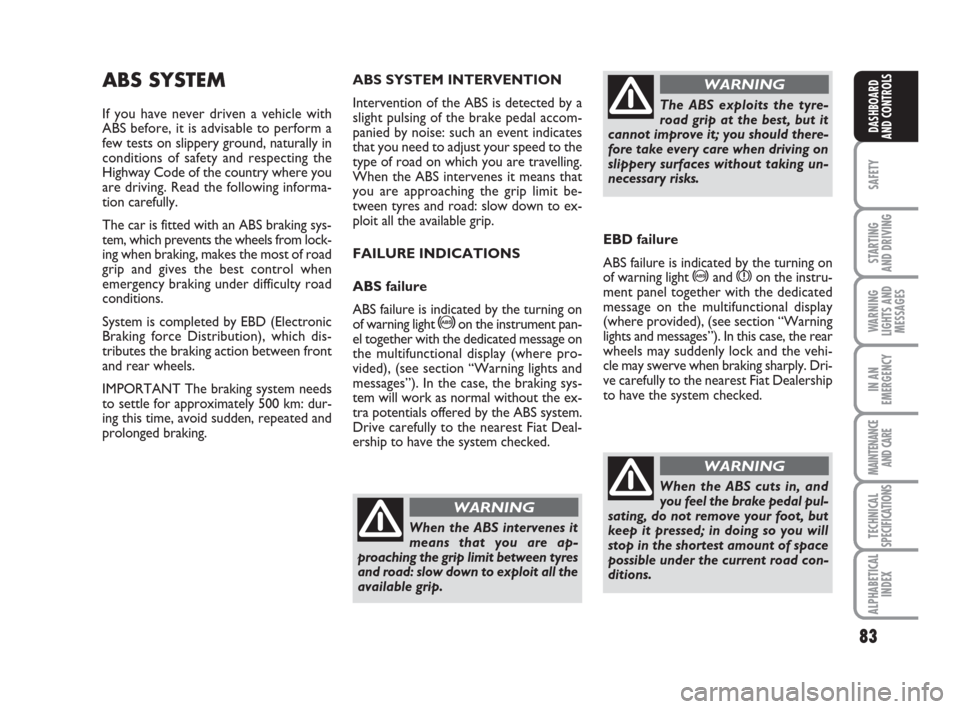
83
SAFETY
STARTING
AND DRIVING
WARNING
LIGHTS AND
MESSAGES
IN AN
EMERGENCY
MAINTENANCE
AND CARE
TECHNICAL
SPECIFICATIONS
ALPHABETICAL
INDEX
DASHBOARD
AND CONTROLS
ABS SYSTEM
If you have never driven a vehicle with
ABS before, it is advisable to perform a
few tests on slippery ground, naturally in
conditions of safety and respecting the
Highway Code of the country where you
are driving. Read the following informa-
tion carefully.
The car is fitted with an ABS braking sys-
tem, which prevents the wheels from lock-
ing when braking, makes the most of road
grip and gives the best control when
emergency braking under difficulty road
conditions.
System is completed by EBD (Electronic
Braking force Distribution), which dis-
tributes the braking action between front
and rear wheels.
IMPORTANT The braking system needs
to settle for approximately 500 km: dur-
ing this time, avoid sudden, repeated and
prolonged braking.ABS SYSTEM INTERVENTION
Intervention of the ABS is detected by a
slight pulsing of the brake pedal accom-
panied by noise: such an event indicates
that you need to adjust your speed to the
type of road on which you are travelling.
When the ABS intervenes it means that
you are approaching the grip limit be-
tween tyres and road: slow down to ex-
ploit all the available grip.
FAILURE INDICATIONS
ABS failure
ABS failure is indicated by the turning on
of warning light
>on the instrument pan-
el together with the dedicated message on
the multifunctional display (where pro-
vided), (see section “Warning lights and
messages”). In the case, the braking sys-
tem will work as normal without the ex-
tra potentials offered by the ABS system.
Drive carefully to the nearest Fiat Deal-
ership to have the system checked.EBD failure
ABS failure is indicated by the turning on
of warning light >and xon the instru-
ment panel together with the dedicated
message on the multifunctional display
(where provided), (see section “Warning
lights and messages”). In this case, the rear
wheels may suddenly lock and the vehi-
cle may swerve when braking sharply. Dri-
ve carefully to the nearest Fiat Dealership
to have the system checked.
When the ABS intervenes it
means that you are ap-
proaching the grip limit between tyres
and road: slow down to exploit all the
available grip.
WARNING
The ABS exploits the tyre-
road grip at the best, but it
cannot improve it; you should there-
fore take every care when driving on
slippery surfaces without taking un-
necessary risks.
WARNING
When the ABS cuts in, and
you feel the brake pedal pul-
sating, do not remove your foot, but
keep it pressed; in doing so you will
stop in the shortest amount of space
possible under the current road con-
ditions.
WARNING
Page 90 of 210

89
SAFETY
STARTING
AND DRIVING
WARNING
LIGHTS AND
MESSAGES
IN AN
EMERGENCY
MAINTENANCE
AND CARE
TECHNICAL
SPECIFICATIONS
ALPHABETICAL
INDEX
DASHBOARD
AND CONTROLS
FAILURE INDICATIONS
See the “Warning lights and messages”
chapter.
OPERATION WITH TRAILER
The system is deactivated automatically
when the trailer electric cable plug is fit-
ted into the car tow hook socket.
The sensors are automatically enabled
again when the trailer cable plug is re-
moved.It is vital that the sensors are
always clean in order for the
system to work properly.
Take great care when clean-
ing the sensors not to scratch or dam-
age them; avoid using dry, rough or
hard cloths. Clean the sensors with
clean water with the addition of car
shampoo if necessary. In washing sta-
tions, clean the sensors quickly, keep-
ing the steam jet/high pressure wash-
ing nozzles at least 10 cm away from
the sensors.
The ultimate responsibility
when parking and carrying
out other dangerous manoeuvres still
rests with the driver. Always make
sure that there are no people, ani-
mals or objects in the way when car-
rying out these manoeuvres. Parking
sensors are designed to assist drivers:
in all cases, you must always pay the
utmost attention during potentially
dangerous manoeuvres, even when
these are carried out a low speed.
WARNING
GENERAL WARNINGS
❒When parking, take the utmost care
to obstacles that may be set above or
under the sensors.
❒Objects set close to the car, under
certain circumstances are not detect-
ed and could therefore cause damages
to the car or be damaged.
❒indications sent by the sensors can be
altered by dirt, snow or ice deposit-
ed on the sensors or by ultrasound
systems (e.g.: truck pneumatic brakes
or pneumatic hammers) set nearby the
car.
Page 98 of 210
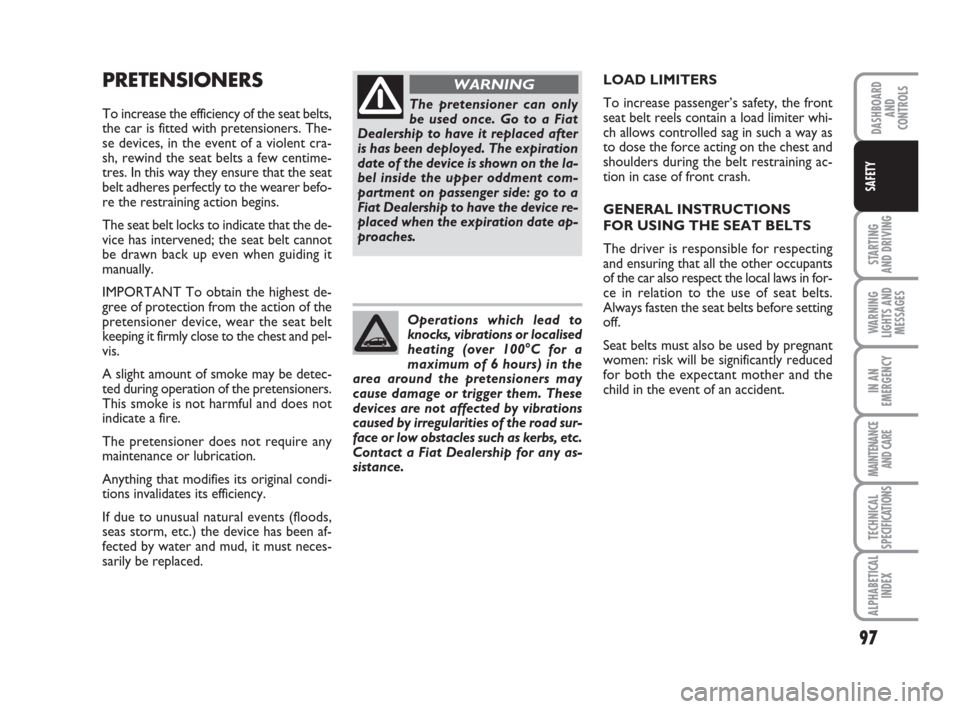
97
STARTING
AND DRIVING
WARNING
LIGHTS AND
MESSAGES
IN AN
EMERGENCY
MAINTENANCE
AND CARE
TECHNICAL
SPECIFICATIONS
ALPHABETICAL
INDEX
DASHBOARD
AND
CONTROLS
SAFETY
PRETENSIONERS
To increase the efficiency of the seat belts,
the car is fitted with pretensioners. The-
se devices, in the event of a violent cra-
sh, rewind the seat belts a few centime-
tres. In this way they ensure that the seat
belt adheres perfectly to the wearer befo-
re the restraining action begins.
The seat belt locks to indicate that the de-
vice has intervened; the seat belt cannot
be drawn back up even when guiding it
manually.
IMPORTANT To obtain the highest de-
gree of protection from the action of the
pretensioner device, wear the seat belt
keeping it firmly close to the chest and pel-
vis.
A slight amount of smoke may be detec-
ted during operation of the pretensioners.
This smoke is not harmful and does not
indicate a fire.
The pretensioner does not require any
maintenance or lubrication.
Anything that modifies its original condi-
tions invalidates its efficiency.
If due to unusual natural events (floods,
seas storm, etc.) the device has been af-
fected by water and mud, it must neces-
sarily be replaced.LOAD LIMITERS
To increase passenger’s safety, the front
seat belt reels contain a load limiter whi-
ch allows controlled sag in such a way as
to dose the force acting on the chest and
shoulders during the belt restraining ac-
tion in case of front crash.
GENERAL INSTRUCTIONS
FOR USING THE SEAT BELTS
The driver is responsible for respecting
and ensuring that all the other occupants
of the car also respect the local laws in for-
ce in relation to the use of seat belts.
Always fasten the seat belts before setting
off.
Seat belts must also be used by pregnant
women: risk will be significantly reduced
for both the expectant mother and the
child in the event of an accident.The pretensioner can only
be used once. Go to a Fiat
Dealership to have it replaced after
is has been deployed. The expiration
date of the device is shown on the la-
bel inside the upper oddment com-
partment on passenger side: go to a
Fiat Dealership to have the device re-
placed when the expiration date ap-
proaches.
WARNING
Operations which lead to
knocks, vibrations or localised
heating (over 100°C for a
maximum of 6 hours) in the
area around the pretensioners may
cause damage or trigger them. These
devices are not affected by vibrations
caused by irregularities of the road sur-
face or low obstacles such as kerbs, etc.
Contact a Fiat Dealership for any as-
sistance.
Page 102 of 210
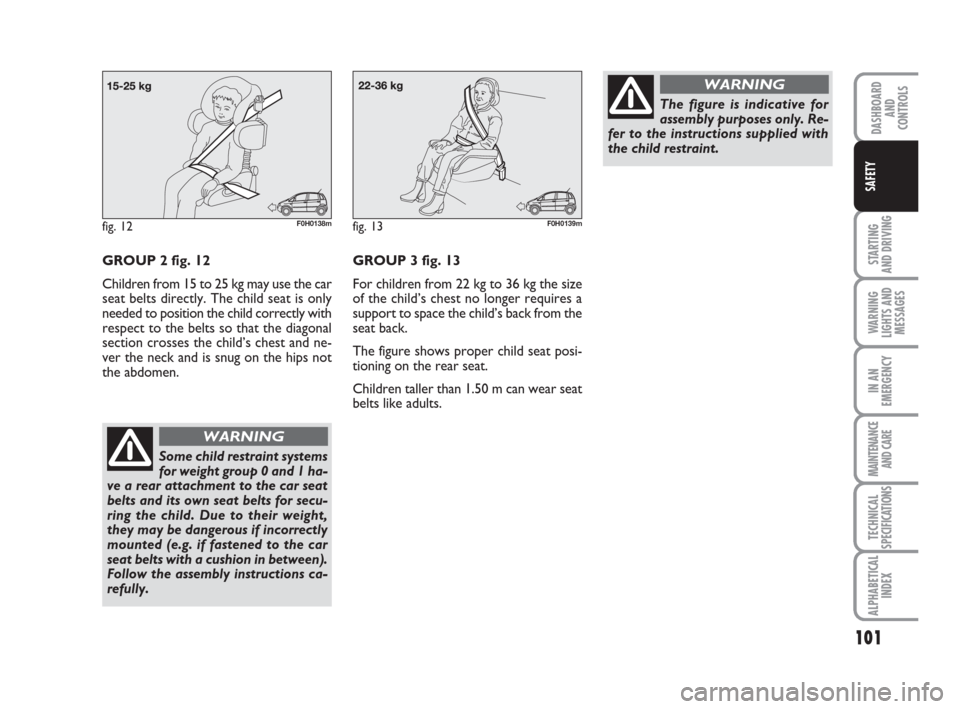
101
STARTING
AND DRIVING
WARNING
LIGHTS AND
MESSAGES
IN AN
EMERGENCY
MAINTENANCE
AND CARE
TECHNICAL
SPECIFICATIONS
ALPHABETICAL
INDEX
DASHBOARD
AND
CONTROLS
SAFETY
fig. 12F0H0138m
GROUP 2 fig. 12
Children from 15 to 25 kg may use the car
seat belts directly. The child seat is only
needed to position the child correctly with
respect to the belts so that the diagonal
section crosses the child’s chest and ne-
ver the neck and is snug on the hips not
the abdomen.
Some child restraint systems
for weight group 0 and 1 ha-
ve a rear attachment to the car seat
belts and its own seat belts for secu-
ring the child. Due to their weight,
they may be dangerous if incorrectly
mounted (e.g. if fastened to the car
seat belts with a cushion in between).
Follow the assembly instructions ca-
refully.
WARNING
fig. 13F0H0139m
The figure is indicative for
assembly purposes only. Re-
fer to the instructions supplied with
the child restraint.
WARNING
GROUP 3 fig. 13
For children from 22 kg to 36 kg the size
of the child’s chest no longer requires a
support to space the child’s back from the
seat back.
The figure shows proper child seat posi-
tioning on the rear seat.
Children taller than 1.50 m can wear seat
belts like adults.
Page 107 of 210
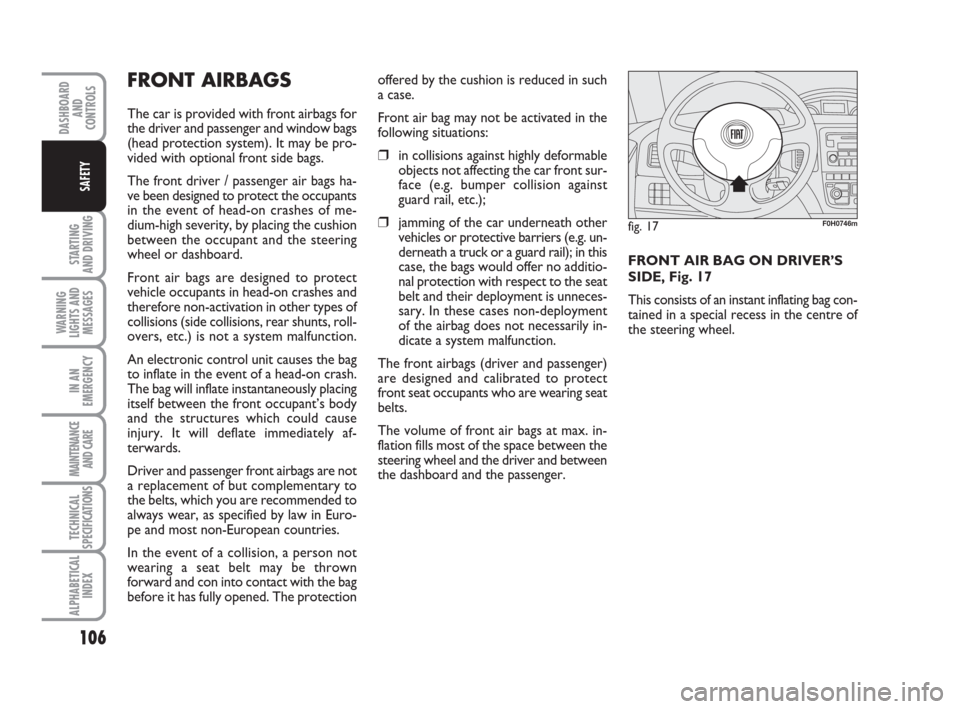
106
STARTING
AND DRIVING
WARNING
LIGHTS AND
MESSAGES
IN AN
EMERGENCY
MAINTENANCE
AND CARE
TECHNICAL
SPECIFICATIONS
ALPHABETICAL
INDEX
DASHBOARD
AND
CONTROLS
SAFETY
FRONT AIRBAGS
The car is provided with front airbags for
the driver and passenger and window bags
(head protection system). It may be pro-
vided with optional front side bags.
The front driver / passenger air bags ha-
ve been designed to protect the occupants
in the event of head-on crashes of me-
dium-high severity, by placing the cushion
between the occupant and the steering
wheel or dashboard.
Front air bags are designed to protect
vehicle occupants in head-on crashes and
therefore non-activation in other types of
collisions (side collisions, rear shunts, roll-
overs, etc.) is not a system malfunction.
An electronic control unit causes the bag
to inflate in the event of a head-on crash.
The bag will inflate instantaneously placing
itself between the front occupant’s body
and the structures which could cause
injury. It will deflate immediately af-
terwards.
Driver and passenger front airbags are not
a replacement of but complementary to
the belts, which you are recommended to
always wear, as specified by law in Euro-
pe and most non-European countries.
In the event of a collision, a person not
wearing a seat belt may be thrown
forward and con into contact with the bag
before it has fully opened. The protectionoffered by the cushion is reduced in such
a case.
Front air bag may not be activated in the
following situations:
❒in collisions against highly deformable
objects not affecting the car front sur-
face (e.g. bumper collision against
guard rail, etc.);
❒jamming of the car underneath other
vehicles or protective barriers (e.g. un-
derneath a truck or a guard rail); in this
case, the bags would offer no additio-
nal protection with respect to the seat
belt and their deployment is unneces-
sary. In these cases non-deployment
of the airbag does not necessarily in-
dicate a system malfunction.
The front airbags (driver and passenger)
are designed and calibrated to protect
front seat occupants who are wearing seat
belts.
The volume of front air bags at max. in-
flation fills most of the space between the
steering wheel and the driver and between
the dashboard and the passenger.FRONT AIR BAG ON DRIVER’S
SIDE, Fig. 17
This consists of an instant inflating bag con-
tained in a special recess in the centre of
the steering wheel.fig. 17F0H0746m